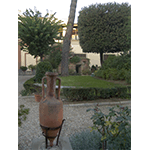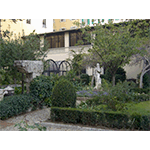Museo Archeologico Nazionale di Firenze [National Archaeological Museum of Florence]
In 1870, when Florence was capital of the Kingdom of Italy, Victor Emanuel II instituted the "Etruscan" Museum alongside the "Egyptian" one, on the premises of the Monastery of Sant'Onofrio (known as Fuligno) in Via Faenza. In 1881 the collections were moved to Via della Colonna, where they became part of the Royal Archaeological Museum. The current arrangement displays a good part of the Medici-Lorraine collection of Etruscan, Greek and Roman antiquities, which had previously been exhibited in the Uffizi Gallery, and some of the objects from the Etruscan topographic section of the Museum, damaged during the flood of 1966 and subsequently restored. The Archaeological Museum, located in the seventeenth-century Palazzo della Crocetta, also houses the Egyptian Museum, in Italy second in importance only to that of Turin.
Among the objects of scientific interest found in the Museum is a small collection of measurement instruments of various kinds, from Egyptian, Etruscan and Roman times. They consist of balances and lever scales with the relevant weights, measures of capacity, a model of a cubit and devices for measuring time from ancient Egypt.
Of exceptional interest is the monumental garden, laid out already in the 16th century at the order of Cosimo II de' Medici, but extensively remodelled in the following centuries. Little remains of the arrangement dating from the first half of the 18th century designed by the gardener of Boboli, Francesco Romoli, who laid out a dozen or so regular beds in which citrus trees were planted. The garden as it appears today was planned, instead, by the Museum's first director, Luigi Milani, who in the early years of the 20th century had placed there Etruscan tombs discovered at that time and removed from their original sites. To these were added boundary stones and statues, in a layout that, in the intention of the director, was designed to link the garden conceptually to the ground floor of the Palazzo, where the Museum's topographical collection was displayed.
****************************
Texts by Elena Fani
English translation by Catherine Frost
Last update 08/feb/2008





